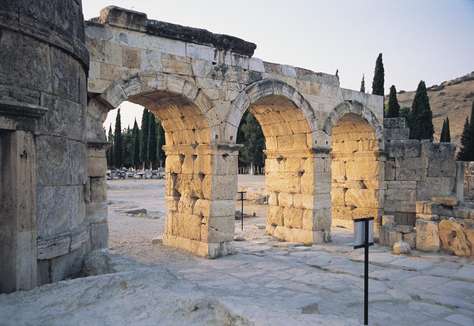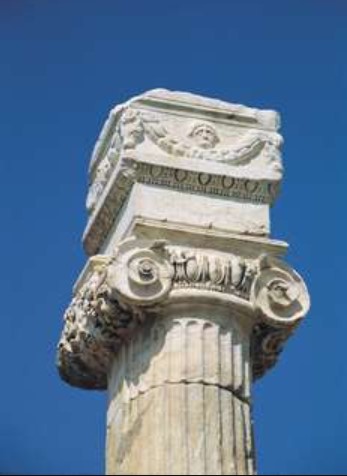
Hierapolis, the ancient city next to Pamukkale, is one of the most exotic sights in the world. This UNESCO World Heritage site is one of the most popular tourist destinations in Turkey. The so-called Holy City was established by Eumenes II, King of Pergamon, in 188 BC and was named after the Amazon queen Hiera, wife of Telephos, the founder of Pergamon.
Hierapolis: a Major Textile Centre
With its thermal waters and sacred Plutonium, Hierapolis developed rapidly and was exempted from taxes during the Roman period. The city experienced its golden age in the second and third centuries when it was an important textile centre, which it remains today. Hierapolis was also famous for its carpets and kilims. Together with nearby Laodicea and Colossae, Hierapolis was the commercial capital of the region.
In the late 17th century, the ruins of Hierapolis were discovered by adventurous travellers, but it was not until the 1800s that excavations began. Since 1957, the excavations have been lead by a team of Italian archaeologists. Theirs is no easy task: Hierapolis is covered in a 1.5-metre thick layer of calcium deposited by the thermal waters that overran the deserted city. Indeed, they have to use heavy machinery to dig through the deposits.

Not an ordinary cemetery
Begin your tour of Hierapolis in its huge necropolis filled with a stunning variety of tombs and sarcophagi. Its very size is proof of the wealth and prosperity of the town.
Archaeological museum
At the end of the necropolis stands a large Byzantine bath. The main avenue is 1 kilometre long and 13 metres wide. The large Frontinus Gate at the northern end of the avenue was built in 82-83 AD. To the left of the gate is a colonnaded structure that is one of the largest ancient toilets in the world. Built in the 2nd century AD, the Agora measures 170 metres wide and 280 metres long, making it an ancient precursor of today’s shopping malls.
At the crossroads of the main avenue and another street is the great bath, today used as an archaeological museum. The friezes brought here from the theatre are particularly worth seeing.
Swimming over ancient ruins
Up the road from the museum is the Sacred Pool. Enjoy an unforgettable swim in its 36-degree waters filled with ancient ruins.
Behind the pool, a road leads to a monumental fountain, a temple of Apollo and a Plutonium, a sanctuary of Hades (Pluto), the god of the underworld.
Hierapolis has two theatres; the first theatre is in the ancient Greek style, cut into the side of a mountain. The second, a Roman theatre with 50 rows of seats, is one of the best-preserved structures in Anatolia. Construction of the theatre began in 62 AD but was not completed until 206-208 AD. Hierapolis’ important Byzantine buildings include the Martyrium of St Philip the Apostle, the 6th century basilica and the 7th century church.
How to get to Hierapolis
Hierapolis is 19 kilometres from Denizli. To get to Hierapolis, take a minibus for Karahayıt or Pamukkale from Denizli bus station. You can also take a taxi or hire a car. Take the Ankara road and turn left before Akhan.
Where to stay
The best hotels are in Karahayıt. The 5-star Spa Hotel Colossae Thermal (www.colossaehotel.com, Tel: +90 258-271 41 56) has indoor and outdoor thermal pools. The 5-star Polat (Tel: +90 258-271 41 10) and 4-star Richmond (www.richmondhotels.com.tr Tel: +90 0258-271 42 94) are also good options.
Where to eat
The best restaurants in Denizli are Umi in Bayramyeri (+90 258- 261 22 20), Mantar Restaurant, 5 km down the Antalya road (www.mantar.com.tr, +90 258-266 05 74) and Değirmende Alabalık (Trout) in the village of Karakurt (+90 258-213 30 37). For Denizli-style kebap, head to the restaurants along Eski Saraykoy Caddesi. Kahve Tadı in Çamlık serves wonderful cakes (+90 258-212 30 29).
